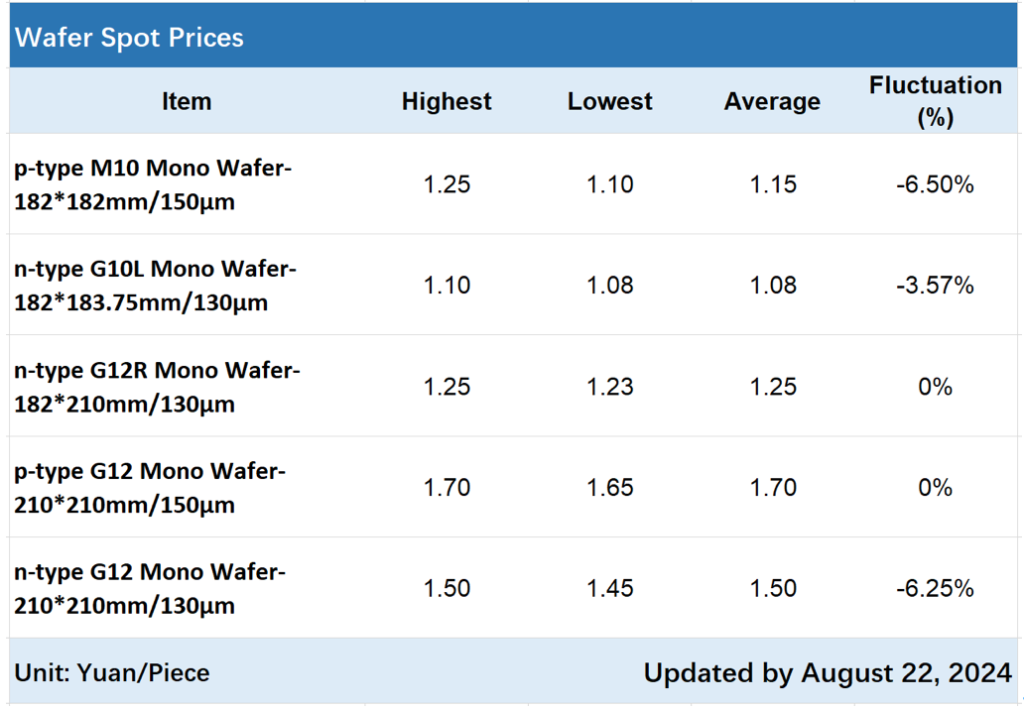LONGi Solar stated that the price of wafers has already fallen below the cash cost. In order to develop the market and taking into account the relationship between supply and demand, the company has moderately increased its wafer price. It is hoped that through the price adjustment, the industry will get out of the quagmire of low-price competition and return to a healthy competitive environment.
When asked whether the supply increase will affect sales, LONGi Solar said that wafer prices have continuously fallen below costs since the second quarter of the year. Even after the price increase, the company may still be under financial pressure and it may take some time for the industry to adjust the price.
Then, on August 27, TCL Zhonghuan announced its latest wafer prices, which also increased. According to the adjusted wafer supply, the G10N wafer was priced at 1.15 CNY/piece (10.16 USD/piece), the G12RN at 1.3 CNY/piece (0.18 USD/piece), and the G12N at 1.5 CNY/piece (0.21 USD/piece).
TCL Zhonghuan stated that the company will reduce its inventory and improve the supply and demand ratio in the industry by reducing its own wafer production rate accordingly. The price increase is expected to stabilize market expectations, maintain the sustainable development of the industry and improve the company’s operating performance.
Losses due to falling wafer prices
Prior to these increases, the Silicon Industry Branch updated its wafer quotation on August 23, and the transaction prices for M10, N-type G10L and N-type G12 mono wafers all fell significantly.
Among them, the average transaction price of N-type G10L monowafers decreased to CNY 1.08/piece (US$0.15/piece), down 3.75% month-on-month; the average transaction price of N-type G12R monowafers remained at CNY 1.25/piece (US$0.18/piece), and the average transaction price of N-type G12 monowafers decreased to US$1.5/piece (US$0.21/piece), down 6.25% month-on-month.
At the same time, the average transaction price of P-type M10 mono wafers decreased to CNY 1.15/piece (US$0.16/piece), a decrease of 6.5% month-on-month. These trends are shown in the table below.

It is worth noting that the operating rates of LONGi Solar and TCL Zhonghuan were not disclosed in this round of bidding. The Silicon Industry Branch said that the reduction of wafer production by the leading companies may still have a positive impact on the stabilization of the supply chain in the medium and long term.
Currently, more than half of the wafer industry’s inventory is concentrated in one or two companies. In the short term, the production plans of these companies will be the focus of the market, while in the long term, market prices are expected to return to reasonable levels as capacities are quickly exhausted at different stages of the supply chain.
In the first half of 2024, the wafer segment led the introduction of irrational price competition due to the worsening of the supply and demand imbalance in the industry. Although the top-tier manufacturers in the market maintained the industry-leading cost per watt, the rate of cost reduction was not as fast as the decline in market prices. At the beginning of the second quarter, wafer companies as a whole were in a state of serious liquidity loss.
Judging by the published financial results, the half-year reports of leading wafer manufacturers also show a rather miserable performance. For example, LONGi Solar expects a net loss of 4.8 to 5.5 billion CNY (680 to 770 million US dollars) in the first half of the year. TCL Zhonghuan, on the other hand, lost more than 3 billion CNY (420 million US dollars) in the first half of the year and achieved a gross profit margin of -9.25%, a year-on-year decline of 34.13%.
According to TCL Zhonghuan leadership, the strong capital intensity of the photovoltaic industry means that the cost model of photovoltaic companies usually covers the entire cost line, including bill of materials costs.

